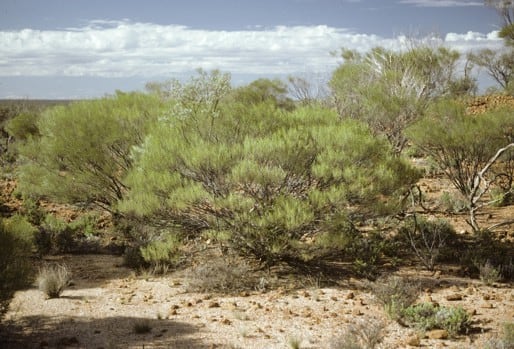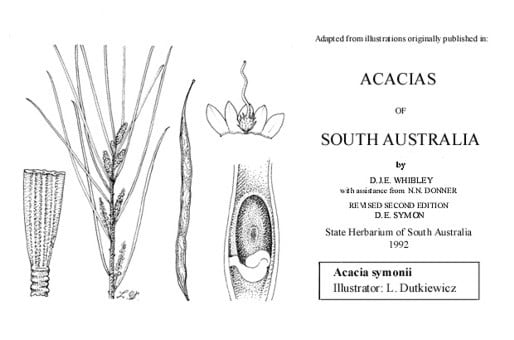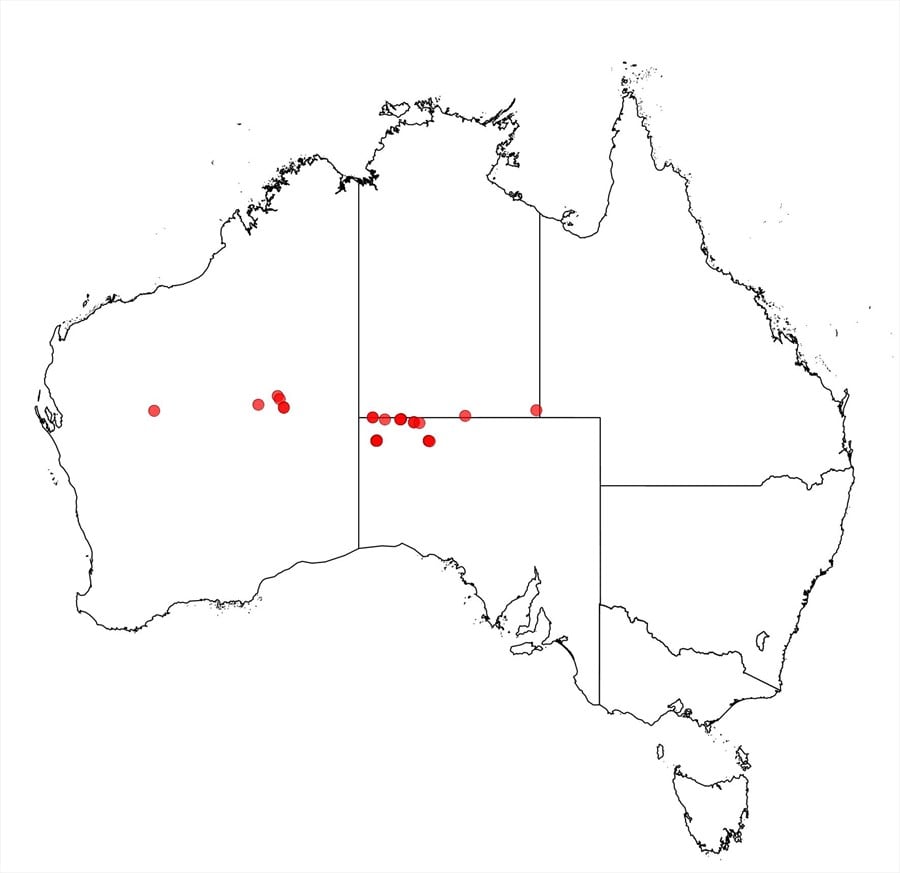Acacia symonii Whibley
WATTLE
Acacias of Australia
Common Name
Symons Wattle
Family
Fabaceae
Distribution
Uncommon species with a scattered distribution in the central arid zone. It occurs in S.A. around the Victory Basin in the Everard Ra. and from Mt Lindsay in the Birksgate Ra., and in the Beddome Ra. (N.T.), and in the Gibson and Little Sandy Deserts at Mt Nossiter, Mt Everard and Mt Beadell (W.A.).
Description
Shrub or tree 2–5 (–8) m tall, bushy-crowned. Branchlets glabrous or sometimes minutely appressed-hairy at the resin-ribbed apices. Phyllodes ascending to erect, linear, straight to slightly incurved, 8–14 cm long, 1.5–3 mm wide, acuminate (with tip commonly slightly curved), not rigid, subglaucous to grey-green, minutely appressed-hairy when young otherwise glabrous, normally 3-nerved per face with the more prominent central nerve and marginal nerves resinous, not reticulate between nerves. Inflorescences simple, commonly 1 per axil; peduncles 3–6 mm long, minutely appressed-hairy to ±glabrous, resinous; spikes 11–15 mm long, 4 mm diam., sometimes interrupted. Flowers 5-merous; sepals 2/3-united; calyx c. 1/5 length of petals. Pods linear, raised over and slightly constricted between seeds, to 7 cm long, 2–3 mm wide, ±firmly chartaceous, glabrescent; margins yellowish, shiny resinous. Seeds longitudinal, oblong, 3 mm long, glossy, tan; aril terminal, whitish.
Habitat
Grows in stony red soil amongst granitic rocks on lower slopes of low, rocky hills, with mulga (W.A., N.T.) and A. olgana (S.A.).
Specimens
W.A.: Little Sandy Desert, Mt Nossiter, 125 km NE of Carnegie HS on ‘Gunbarrel Hwy’, B.R.Maslin 5644 (AD, PERTH). N.T.: Beddome Ra., New Crown Stn, P.K.Latz 12484 & H.Coulson (DNA, NSW, PERTH). S.A.: Everard Ra., southernmost hills above Victory Basin, 16 Dec. 1975, K.Shurcliff (AD, PERTH); near top of Mt Lindsay, D.J.E.Whibley 6581 (AD, PERTH).
Notes
Closest to A. websteri which has branchlets flattened and lacking resin ribs at their apices, generally shorter phyllodes with more strongly raised main nerves, shorter and denser spikes and free sepals. While resembling A. longissima (Qld and N.S.W.) in having long linear, non-rigid phyllodes with delicately curved tips, there is little relationship.
FOA Reference
Data derived from Flora of Australia Volumes 11A (2001), 11B (2001) and 12 (1998), products of ABRS, ©Commonwealth of Australia
Author
Minor edits by B.R.Maslin & J.Rogers
B.R.Maslin, R.S.Cowan
This identification key and fact sheets are available as a mobile application:
URL: https://apps.lucidcentral.org/wattle/
© Copyright 2018. All rights reserved.













